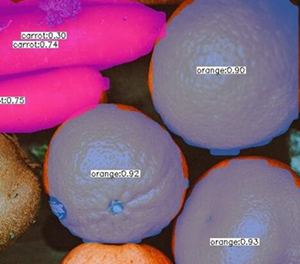Segmentation
Description

Segmentation is a computer vision technique that divides images into distinct categories or regions. It assigns each pixel to a specific class, allowing for object recognition and image analysis. It has various applications in fields like quality control, inspection, autonomous driving, and object detection.
Furthermore, it has various applications in fields like enabling quality control by identifying defects in manufacturing processes, enhances automation through object recognition, aids in agriculture for crop monitoring and management, improves surveillance and security by tracking objects of interest, facilitates industrial inspection for defect detection, and assists in object counting and localization for inventory management. With its versatility, segmentation proves to be a valuable tool, enhancing efficiency and automation in diverse industrial processes.
Settings
Model Folder Path
The model folder path is the path to the folder containing the model files. The model files are the files that are used to segmentation in the images. The model folder path can be a local path or a remote path.
See Model Folder Structure for more information about how to structure the model folder.
Supported Architectures
Here are the supported frameworks and architectures:
TensorFlow 1
- Mack R-CNN)
- Inception V2
Zene UI
The user can choose the model folder path by clicking on the folder icon and selecting the folder containing the model files (see File Explorer for more information).
In this example, the model folder is located at D:/mask_rcnn_inception_v2. Below the model path selector the user can see the Model Name (folder name), and the model Framework.
Architecture
The architecture is the type of model that will be used to segment the images. See Supported Architecture for more information.
Confidence Threshold
The confidence threshold is the minimum confidence score a segmentation should have to be considered valid. Segmentations with confidence scores below this threshold will be discarded. A higher confidence threshold will result in fewer segmentations, but with higher accuracy, whereas a lower threshold will result in more segmentations, but with potentially lower accuracy.
Ignore Labels
The ignored labels are the labels that will be ignored during the segmentation. For example, if the user want to ignore the person label, the user can add person to the ignored labels list.
Advanced Settings
Whether to enabled advanced settings. The advanced settings allow the user to have more control over the model parameters.
Please use the advanced settings with caution as changing the parameters could result in unexpected behaviour.
To RGB
Advanced SettingsConvert from BGR colours (default in Zene) to RGB colours.This is useful when using models trained on images with different channel orders.
Scale
Advanced SettingsThe scale is the scale factor that is applied to the input image. The scale factor is used to normalise the input image before it is passed to the model. The scale factor is calculated by dividing the input image by the scale factor. A higher scale factor will result in a smaller input image, while a lower scale factor will result in a larger input image.
Mean
Advanced SettingsThe mean is the mean value that is subtracted from the input image. The mean value is used to normalise the input image before it is passed to the model. The mean value is calculated by subtracting the input image by the mean value. A higher mean value will result in a darker input image, while a lower mean value will result in a brighter input image.
Input Pixel (width and height)
Advanced SettingsThe input pixel is the size of the input image. The input image is the image that is passed to the model. The user can specify the width and height of the input image.
Display Results
Overlay Results
Whether to draw the results on top of the image frame.